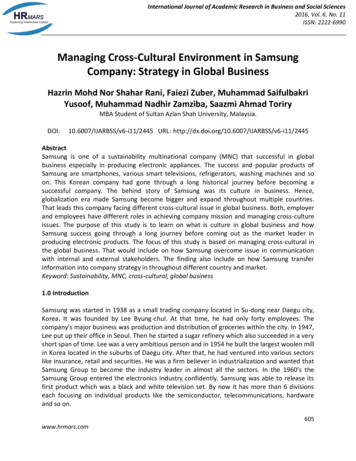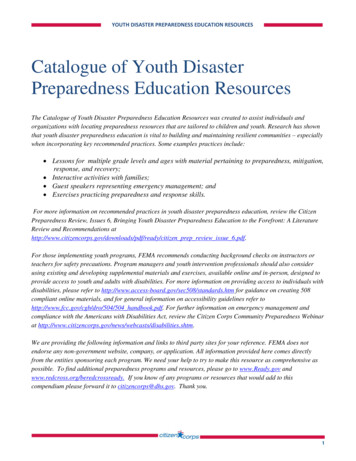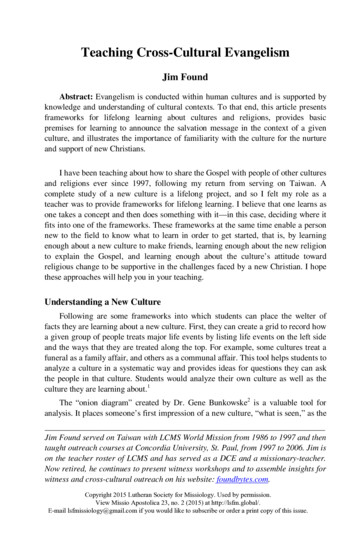
Transcription
International Journal of Academic Research in Business and Social Sciences2016, Vol. 6, No. 11ISSN: 2222-6990Managing Cross-Cultural Environment in SamsungCompany: Strategy in Global BusinessHazrin Mohd Nor Shahar Rani, Faiezi Zuber, Muhammad SaifulbakriYusoof, Muhammad Nadhir Zamziba, Saazmi Ahmad ToriryMBA Student of Sultan Azlan Shah University, Malaysia.DOI:10.6007/IJARBSS/v6-i11/2445 URL: actSamsung is one of a sustainability multinational company (MNC) that successful in globalbusiness especially in producing electronic appliances. The success and popular products ofSamsung are smartphones, various smart televisions, refrigerators, washing machines and soon. This Korean company had gone through a long historical journey before becoming asuccessful company. The behind story of Samsung was its culture in business. Hence,globalization era made Samsung become bigger and expand throughout multiple countries.That leads this company facing different cross-cultural issue in global business. Both, employerand employees have different roles in achieving company mission and managing cross-cultureissues. The purpose of this study is to learn on what is culture in global business and howSamsung success going through a long journey before coming out as the market leader inproducing electronic products. The focus of this study is based on managing cross-cultural inthe global business. That would include on how Samsung overcome issue in communicationwith internal and external stakeholders. The finding also include on how Samsung transferinformation into company strategy in throughout different country and market.Keyword: Sustainability, MNC, cross-cultural, global business1.0 IntroductionSamsung was started in 1938 as a small trading company located in Su-dong near Daegu city,Korea. It was founded by Lee Byung-chul. At that time, he had only forty employees. Thecompany’s major business was production and distribution of groceries within the city. In 1947,Lee put up their office in Seoul. Then he started a sugar refinery which also succeeded in a veryshort span of time. Lee was a very ambitious person and in 1954 he built the largest woolen millin Korea located in the suburbs of Daegu city. After that, he had ventured into various sectorslike insurance, retail and securities. He was a firm believer in industrialization and wanted thatSamsung Group to become the industry leader in almost all the sectors. In the 1960’s theSamsung Group entered the electronics industry confidently. Samsung was able to release itsfirst product which was a black and white television set. By now it has more than 6 divisionseach focusing on individual products like the semiconductor, telecommunications, hardwareand so on.605www.hrmars.com
International Journal of Academic Research in Business and Social Sciences2016, Vol. 6, No. 11ISSN: 2222-6990The company began to create its name as the biggest electronic company in the world startedwith three days speech from Lee Kun Hee who was Samsung’s Chairman from 1987 in GermanHotel 1993. He went on a world tour to see how his company doing internationally. From thetrip, he was not satisfied on what he saw. He stated that his company must be like GeneralElectric (G.E.) by the year 2000. In June 1993, he called hundreds of Samsung’s executives for abig meeting which held in Falkenstein Gran Kempinski Hotel. He listed the blue print on hisvision and what they have to do to become successful.His speech became “Frankfurt Declaration of 1993”. The famous speech was “Changeeverything but your wife and children”. The content of the Frankfurt Declaration is called NewManagement, its principles distilled into a 200 pages book that’s distributed to all Samsungemployees including the cartoon version for the employees who couldn’t read. That leadSamsung revaluated their culture for its sustainability in the global business. Today, Samsung isthe world's biggest supplier of memory chips, televisions and smartphones, with the companyalso being one of the world's top display panel manufacturers.2.0 Nature of CultureCulture is determined of the way people think, speak, perceive, and behave. Culture sharedunderstanding of meaning and it is the core of society stability (Corn & Kanter, 1994). In otherword, it is used to describe the behaviors that represent the general operating norms in anenvironment (Fariza, Abdul Rahim, & Asmat Nizam, 2007). Cultural also explain how membersbehave toward each other and with other groups. First, culture is relative. That means culture isneither right nor wrong. There is no cultural absolute. People of different nationalities simplyperceive the world differently. Each culture has its own view of what is acceptable and notacceptable behavior. Second, culture is not about individual but it is about group behavior. Itrefers to a collective occurrence of shared values and meanings. Third, culture is not inherited.It is derived from the social environment. In other word culture can be learned and be adapted.The fact is people in different countries have different ways of conducting their daily lives.Anthropologist view culture as a biological evolution and the main means of human adaption tothe world; therefore culture encompasses several elements in human life (Fariza, Abdul Rahim,& Asmat Nizam, 2007). It covers spiritual, material, intellectual, and emotion features of societyor a social group. It also includes arts and literature, lifestyle, ways of living, values, traditions,and beliefs. Samsung like other MNCs have its own company culture.3.0 Nature of Culture in Global BusinessNowadays, the ability to communicate effectively can be a challenge in a global environment.Although when two parties speak in the same language, there are still being misunderstandingdue to ethic and cultural differences. There are researches and findings that show how poor606www.hrmars.com
International Journal of Academic Research in Business and Social Sciences2016, Vol. 6, No. 11ISSN: 2222-6990communication can lead to poor company performance. So it is crucial for company tounderstand the impact of globalization on cross-culture communication and it is vital fororganizations looking for creating a competitive advantage in the global market. The economicchallenge today, emphasizes the need for organizations to develop the internal communicationcapacity necessary to monitor and control external threats. People are more globally connectedand there are increasing in ability to communicate across cultural boundaries. MNC mustunderstand how to communicate with employees and customers from different cultures inorder to fulfil the company’s missions and gain values for stakeholders. Even though cultureclash or misunderstood that can potentially lead to obstacles in trying to increase profits andmarket share. Usage of technology had a profound impact on how business communicateglobally and market their products and services.Company involved in global business operations, shows that the relationship of managementand employees is very important. In research conducted by Thomas and Ravlin (1995) it wasfound that participants to whom nationality was more important indicated lower perceptionsof similarity with the manager, lower intentions to associate and lower perceptions ofmanagerial effectiveness. The results of the study strongly indicate that teaching members ofdifferent cultures to behave like each other is an ineffective approach to improving interculturalinteractions in business settings (Thomas & Ravlin, 1995). The core should focus on usingdiversity in culture to create innovation (Cohn, Katzenbach, & Vlak, 2008). Training anddevelopment of individuals involved in intercultural interactions should consist of more thansimply promoting cultural adaptation.Effective communication for business is crucial in guiding to explain whether their product andservices differ from their competitors. The successful company in communication cross-culturemay have advantages and they could avoid spending too much time and resources for solvingcommunication issues either internally or externally. As an individual person, communication isimportant to express ideas to other persons. It same goes to group. Without that, there mightbe a chaos and the mission won’t be achieved of what are the actual ideas are all about to tell.So the communication through cultural understanding is vital to prevent misunderstandingwhich could be caused by prejudices and personal biases.The study on cross-culture communication is focusing on understanding how individualdifferences influence our ability to communicate with others. Since most individuals grow upwithin a single culture having to interact with others from a different culture or background canrepresent a challenge (Fink, Neyer, & Kölling, 2006). The exposure in different cultures affectsthe ability to communicate with others. Fink, Neyer, and Kölling (2006) propose thatresearchers involved in cross-cultural studies should develop an understanding of theinterrelations between cultural dimensions, cultural standards, and personality traits. Thatwould help individual to manage their own cross-culture awareness.607www.hrmars.com
International Journal of Academic Research in Business and Social Sciences2016, Vol. 6, No. 11ISSN: 2222-6990Reza Najafbagy (2008) refers to co-orientation, the ability to familiarize all aspects of one’s ownlife in relation to someone of a different culture, as a primary component of interculturalcommunication. Individuals that have experienced different cultures are more cognizant onhow to alter their communication styles so that others understand the information they aretrying to deliver. Research conducted by Seak and Enderwick (2008) revealed the importance ofproviding cross-cultural communication and training skills for expatriates assigned to foreignlocations in particularly, China, Hong Kong, Taiwan, Japan and South Korea. Now more thanever global organizations must ensure that their employees have the skills required tocommunicate across cultural boundaries. Cross-cultural communication enhances innovation byallowing for collective problem solving and the open dissemination of information (Matthews &Thakkar, 2012).Cohen and Levinthal (1990) define the term absorptive capacity as an organization’s ability toidentify and recognize the value of new external information, absorb it, and implement it intotheir business operations. Company that understand the importance of external information isbetter in using their core competencies to create a competitive advantage. Cross-culturecommunication enhances an organization’s absorptive capacity because it provides a new ofperspective in satisfying the needs of stakeholders. However, when information flows arerandom and there is no apparent directive of how to apply the outside knowledge theorganization will not benefit (Cohen & Levinthal, 1990). Productivity decreases when companymanagement are not able to communicate clearly to transfer into the expected result.Furthermore, conflict and tension arises when workers do not understand how their personalefforts contribute to the overall success of the company.In research conducted by Choi and Chang (2009) it was noted that organizational culturedirectly impacts the attitudes and motivation of employees towards innovation. He added thatthe researchers identified three organizational factors of management support, resourceavailability, and support for learning as key enablers for innovation. He also said that all threefactors were found to be significantly correlated to implementation, however; onlymanagement support was determined to be a significant predictor of innovation. Furthermore,the finding aligns with the conclusion that when worker fully involved in the innovation process,they will success. Therefore, company should implement procedures that encourage innovationthroughout the entire company.4.0 Managing Corporate Culture in SamsungThe company held “Startup Samsung” event at its tech compound in Suwon with its workersand executives to seek how to get rid its hierarchical practices. Samsung eliminate its longdecade rigid corporate structure along with its changing leaderships which to cope with marketweak demand and increasing competition. The company is cutting its internal ranking systemfrom seven to only four levels which to remove a senior-based evaluation system. That isseniority-based performance system – Sawon (Level 1, 2 and 3), Daeri, Chajang and Bujang to608www.hrmars.com
International Journal of Academic Research in Business and Social Sciences2016, Vol. 6, No. 11ISSN: 2222-6990four level of Career Level (CL) system (CL l, 2, 3 and 4) only. The company now allow allemployees to call each other by their English names to improve their communication skill.The unnecessary meeting was reduced with encourage of internal discussion and onlinemeetings. That is how they see how far faster and quicker policies are implemented. Thecompany also limit their internal meeting to only one hour time. All members are encouragedto speak on key topics during meeting. There is a must for management to listen and respect tothe ideas during that meeting. These changes in Samsung’s new business models increase itsstakeholder concern and reflect its corporate sustainability. The model come based on fasterimplementation, innovative thinking and creativity. Hence, it’s also resulted on time delivery,output commitment and competitive pricing.The globalization and the rise of inexpensive Chinese products lead Samsung to loose inmanufacturing powerhouse. That make the company focusing to prepare imminent actionplans to change the firm’s cultural. So Samsung took a sudden action to improve managementefficiency by selling its non-core assets and restructuring its business unit with overlappingfunctions. Now Samsung is on track to understand the latest trends in Silicon Valley by gettingpatents in important areas such as mobile payment, Internet of Things which all of these wererecognized by the company as bring the next growth engine.Under the new system, a new guideline to evaluate the employee’s performance has beensetup. Employees who are competitive and don’t have disciplinary report will be promotedregardless of seniority. The change makes company’s executives feel inferior and even thinkunderpaid compared to executive at their age in other company. The top-down hierarchysystem has long functioned as a key integral part of Confucian-oriented Korean corporateculture, that make some said eradication of the hierarchy won’t be that easy.Samsung is unique because of its focus on human resources and risk taking initiatives(Matthews & Thakkar, 2012). Samsung is recognized as a global industry leader because of itsinner capacity to take advantage of distinct initiatives (J. Ku-Hyun, 2009). It hires a smallpercentage of non-Koreans inside Korea but employs a higher percentage of non-Koreansoutside of Korea (Matthews & Thakkar, 2012). The culture of the organization is very familycentric. So decision would allow communication at all level of organization.However in Samsung, obstacles of cross-cultural communication arise when employees feelthey are not being appreciated. Each worker expected that they would stay on a job until thattask given was finish. It did not happen that way since the increasing of young workers joiningthe company. Management made the decision to change the workday from five-to-nine toseven-to-four (Lee, Lee, Lee, & Choi, 2005). The change of working period required workers,supervisors and managers to work together in completing daily tasks. The seven-to-fourschedule was a cultural shift that was instigated by new employees entering the company witha different outlook towards work and personal time (Matthews & Thakkar, 2012). Workers609www.hrmars.com
International Journal of Academic Research in Business and Social Sciences2016, Vol. 6, No. 11ISSN: 2222-6990were expected to stay and work proactively on the job until the assignment was finished beforethe office closed at four and everything stopped in time.Furthermore, the others competitive advantages of Samsung include commitment to work thatis translated into speed, highly skilled engineers and technicians, and talented and expertmanagement. Samsung has used these competitive advantages to enhance its relationship withcustomers and develop globally.5.0 Samsung’s Strategy in Global BusinessThe Samsung products were sold in million unit everyday around the world to customers. Witha worldwide customer base, Samsung does not subscribe to a one size fits all philosophy(“Samsung Designs Globally and Adapts Locally for Worldwide Success,” 2013). In addition, itsemployees pride themselves on finding inspiration from observing people’s lives and givingthem options that meet their varying cultural and regional needs.At IFA 2013, Europe’s largest consumer electronics show, Samsung outlined its strategy inbecoming the number one home appliance brand by 2015, highlighting its year-on-year 14%growth in digital appliances (“Samsung Designs Globally and Adapts Locally for WorldwideSuccess,” 2013). The key of success is the research that the company know how the customersapproach and use new technology. So Samsung has created and sell the app (Lowell & Bharat,2012) that fit those needs.Samsung plays an active role in each region in which it operates and understands that culturescan be subtly different (“Samsung Designs Globally and Adapts Locally for Worldwide Success,”2013). Samsung believes that understanding and meeting local needs is the principal to createthe best possible experience. Therefore, Samsung creates product based on local need andtaste.Samsung had setup five Lifestyle Research Labs in Delhi, London, San Jose, Beijing andSingapore. The Labs forecast future ways of living and describes innovation designs. These labsalso define products behavior to predict consumer’s future needs and values including howfamily evolves to working environment, education and cultural trends.Five Product Innovation Teams research had been setup from the labs which supportSamsung’s product division to create innovative and solution concepts. They produce productconcepts 18-24 month ahead of present market. The process started with two until fourmonth’s period by conducting research in term of consumer views. From that, researchergathers the finding and gives to team designer division to build and refine ideas innovatively.The other unit formulates a business strategy and creates the concepts of the products.610www.hrmars.com
International Journal of Academic Research in Business and Social Sciences2016, Vol. 6, No. 11ISSN: 2222-6990Complementing these two divisions are six Design Centres in San Francisco, London, Delhi,Tokyo, Shanghai and Seoul, working to bring the research and concepts to life with awardwinning design excellence. This undertaking is part of Samsung’s extensive research anddevelopment commitment that saw a 10.8 billion investment in 2012 and encompasses over60,000 employees (“Samsung Designs Globally and Adapts Locally for Worldwide Success,”2013).Finally throughout the whole world, Samsung localizes its products to suit specific market needsand desires. The following are a few examples of market and its local products. In United States– French Door Refrigerator with Sparkling Water Dispenser. By observing the increasingdemand for sparkling water in the United States, Samsung introduced a refrigerator thatdispenses carbonated water at the touch of a button. In Bulgaria – Samsung create Smart OvenMC32F. On the other hand, yogurt is an important part of the local diet so Samsung developedan oven able to produce the perfect homemade yogurt in seconds.While in Africa, firstly, Samsung produce SafeSurge TV – To protect against the region’sfrequent power surges and outages, Samsung created LED TVs with increased pressureresistant capacity. Secondly, Free Satellite TV – Satellite tuners were installed directly into TVsto enable viewers to watch free TV services in isolated regions with no cable access. Thirdly,Duracool Refrigerators – These specially insulated refrigerators keep food fresh for eight hoursin the event of a power cut.In Turkey, Samsung produced Top Mounted Refrigerator RT55. The local taste for freshvegetables led Samsung to reduce the size of freezer compartments by 21% and made thefridges narrower to fit the space better available in Turkish homes. Meanwhile in Middle East –Samsung produce DVM Desert which to handle the region’s scorching 40 C temperatures,Samsung built air-conditioners with specially-developed compressors.In India, Samsung produce Twin Top Washing Machine. This a range of washing machines havebeen fitted with wheels to ensure they can be easily moved and connected to alternate poweror water sources in the event of outages. They are also fitted with a special basin to meet thecustom for hand-washing certain clothes before the full wash-cycle.In China market, Samsung produce Fu Yun Monitor, Ji Xiang Fa TV F4280, Ru Yi Hong TV F5080.This colour red and the number 8 are considered lucky, so Samsung’s Chinese product lineincludes PC monitors with red back-covers and LED TVs fitted with 8-shaped stands.While in Korea, Samsung produce Kimchi Refrigerator M9000. Koreans have kimchi, afermented vegetable delicacy, with almost every meal, so Samsung developed a bespokerefrigerator that keeps the air-flow and temperature just right for the perfect kimchi.611www.hrmars.com
International Journal of Academic Research in Business and Social Sciences2016, Vol. 6, No. 11ISSN: 2222-6990In China and Korea market, Samsung create Q9000 Air Conditioner. With the growing desire forminimalist product design in evidence, Samsung developed a sleek, ultra-slim standing airconditioner perfect for design conscious customers. Samsung constantly seeks to discover thetrends and desires that drive consumer needs around the world.6.0 Discussion and ConclusionThere are numbers of proofs for Samsung outstanding achievement. According to The Forbes(May, 2016), Samsung is number 18 of the world’s biggest public company with value of USD161.6 billion, and number 11 in world’s most valuable brands. According to Samsung ElectronicsRanks 7th in Interbrand’s Best Global Brands (2016), Samsung in the 7th ranking of the bestglobal brands. While according to The Fortune 500 (2016), Samsung is number13th in revenues.(Fortune 500, 2016)Challenges in global business are a process that Samsung have been facing. As a global player,Samsung had successfully doing business in 61 countries. This sustainable company succeed inmanaging cross-culture issues worldwide. The problems become challenges and turn intoopportunities that create innovation of various products. The need of China market may bedifferent from the need in Africa and so on.Successful in managing cross-cultural communication creates a dialogue, which is a continuoustransfer of information. This process of transferring information leads our assumptions andclarifies the points which we do not understand. It also provides the opportunity for us to askquestions and confirms the information that has been received. Having a dialogue will reducesconflict in cross-culture issue. It can be managed well when any issues arise. The dialogue onlyoccurs when both parties agree to share information and ensure the transfer of information tohappen.7.0 ReferencesChoi, J. N., & Chang, J. Y. (2009). Innovation Implementation in The Public Sector: AnIntergration of Institutional and Collective Dynamics. Journal of applied Psychology,94(1), 245-253. doi:10.1037/a0012994Cohen, W. M., & Levinthal, D. A. (1989). Absorptive Capacity: A New Perspective on Learningand Innovation. Administrative Science Quarterly, 35, 128-152.Cohn, J., Katzenbach, J., & Vlak, G. (2008). Finding and Grooming Breakthrough Innovators.Harvard Business Review, 86(12), 62-69.Corn, I. R., & Kanter, R. M. (1994). Do Cultural Make a Business Difference?: Contextual FactorsAffecting Cross-cultural Relationship Sucess. Journal of Management Developement,13(2), 5-23. doi:10.1108/02621719410050219Fariza, H., Abdul Rahim, A., & Asmat Nizam, A. (2007). International Business (Second ed.). ShahAlam: Oxford Fajar Sdn. Bhd.612www.hrmars.com
International Journal of Academic Research in Business and Social Sciences2016, Vol. 6, No. 11ISSN: 2222-6990Fink, G., Neyer, A., & Kölling, M. (2006). Understanding Cross-Cultural Management Interaction.Interational Studies of Management & Organization, 36(4), nics/RetrievedfromFortune 500. (2016). Retrieved from The Fortune 2016 Global:http://beta.fortune.com/global500/listLee, H., Lee, J., Lee, J., & Choi, C. (2005, August). Time to change, time for change: How wastime used to change a global company. In Academy of Management Best ConferencePaper (pp. F1-F6).Matthews, L. C., & Thakkar, B. (2012). The Impact of Globalization on Cross-CulturalCommunication. Globalization - Education and Management Agendas, 325-340.doi:10.5772/45816Najafbagy, R. (2008). Problemsof Effective Cross-Cultural Communication and ConflictResolution. Palestine-Israel Journal of Politics, economi and Culture, 15(16), 146-150.Thomas, D. C., & Ravlin, E. C. (1995). Responses of Employees to Cultural Adaption by a ForeignManager. Journal of Applied Psychology, 133-146. doi:10.1037/0021-9010.80.1.133Samsung Designs Globally and Adapts Locally for Worldwide Success. (2013, September dwide-successSamsung Electronics Ranks 7th in Interbrand’s Best Global Brands 2016 (2016, October).Retrieved from eak, N., & Enderwick, P. (2008). The management of New Zealand expatriates in China. TheInternational Journal of Human Resource Management, 19(7), 1298-1313.613www.hrmars.com
Samsung revaluated their culture for its sustainability in the global business. Today, Samsung is the world's biggest supplier of memory chips, televisions and smartphones, with the company also being one of the world's top display panel manufacturers. 2.0 Nature of Culture Culture is determined of the










